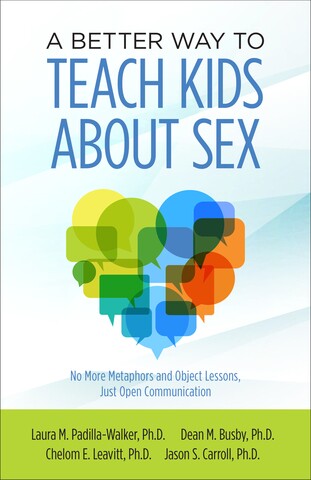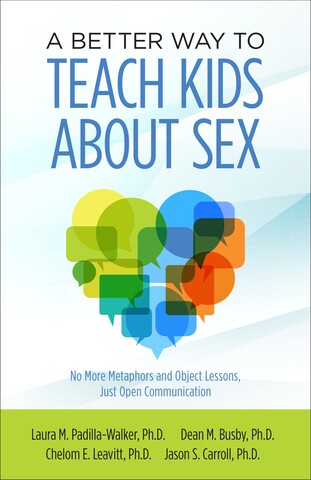For more resources, videos, and tools to help you speak to your children about pornography, visit the Church's website ChurchofJesusChrist.org/addressing-pornography.
Despite the fact that pornography is becoming a common part of our modern culture, most parents still feel ill-equipped to handle these situations when they come up with their children. Sometimes children will voluntarily share their struggles with their parents or priesthood leaders, like Connor did with his parents. But often pornography use is discovered by the parents on a computer or phone, or parents catch their son or daughter using pornography or start to have suspicions about his or her media use patterns. Some teens have observable changes in their mood or behaviors, while others get involved with pornography and view it for some time with no recognizable shifts in their demeanor.
Here are some guiding principles for how to safeguard your children from pornography and how to respond when a child is exposed to or becomes involved with pornography. In particular, we suggest five proactive strategies we can use to help address the issue of pornography in our homes and in our children’s lives. These include (1) learning about pornography, (2) preventing early exposure, (3) replacing myth with truth as well as (4) diagnosing the problem correctly, and (5) being patient and fostering long-term change (which are discussed in a separate article here).
1. Learning about Pornography.
Many parents wonder, “Just how big of a problem is pornography?” A few years ago, our team of researchers at BYU published a highly publicized study in the Journal of Adolescent Research entitled “Generation XXX: Pornography Use and Acceptance among Emerging Adults.” In this study, we documented how prevalent pornography use has become among young adults in the United States. The clear finding from our study was that pornography has moved from the fringe to the mainstream of society. Specifically, we found that 87% of young adult men ages 18 to 25 reported viewing online pornography within the last 12 months and that 50% said they viewed it on at least a weekly basis. Our study also found that 30% of young adult women had viewed or read pornographic material in the last year and that half of the women we sampled believed that viewing pornography was an acceptable way for someone to express their sexuality.
Naturally, these patterns are alarming to us as parents and leaders who are becoming increasingly concerned about the pornographic culture that is emerging in modern society. This alarm has been growing for some time now, and we have been steadily raising the voice of warning about pornography to our young people. In fact, we are now getting to the point where nearly all of our young adults are raised from childhood with repeated warnings about the negative consequences of pornography. . . .
How We Talk to Our Kids About Pornography Matters
What are the consequences of our collective warnings about pornography to our children? Have we been effective? Are we helping our children successfully avoid the pornography pitfalls in our society? As researchers, we are becoming increasingly convinced that our collective voice of warning about pornography has brought mixed results in the rising generation. On the positive side, nearly all of the teens and young adults in the Church see pornography as a serious matter. Rarely do we hear anyone try to dismiss or minimize the potential negative impacts of pornography involvement. We can safely conclude that the awareness level of the “pornography problem” is very high.
However, we have also come to believe that the warnings young people are receiving from their parents and leaders about pornography are often leading to some unintended negative side effects. These side effects are not necessarily a result of the fact that we are warning our children about pornography but rather are a result of how we are warning them. Also, while a few of these side effects are the result of what parents are saying about pornography, many of the biggest problems are the result of what we are not talking about—specifically, healthy sexuality and natural sexual development. Too many teens and young adults are learning about pornography in unspecific and isolated ways.
While it is debatable whether or not our warnings about pornography and sexual permissiveness have changed the overall behaviors of teens and young adults in the Church, it is clear they have influenced young people’s feelings about sex. And while young men have primarily been the ones targeted by these messages, it is clear that it is our young women who are paying the most attention. And what have they heard? They have heard that they should be very concerned about pornography use among young men and how it can impact their future marriage one day.
The key problem is that this concern about pornography isn’t just about pornography. It’s about sex altogether. The message that has been received is, “Porn is bad and porn is sex, so sex is bad.” Why would our young people believe this? Because for many of them, teachings about pornography have not been integrated into a broader understanding of sexuality. In their experience, pornography was what was talked about—not healthy sexuality, not the beauty of sexual intimacy between spouses, not an understanding of how their body is endowed with a powerful sexual response system.
As a parent, the best thing you can do to safeguard your children from ongoing struggles with pornography is to raise them with an understanding of their sexual nature and ways that pornography undermines their potential for sexual wholeness in marriage one day. In reference to pornography and other inappropriate expressions of sexuality, Elder Jeffrey R. Holland explained, “If we stop chopping at the branches of this problem and strike more directly at the root of the tree, not surprisingly we find lust lurking furtively there. . . . Why is lust such a deadly sin? Well, in addition to the completely Spirit-destroying impact it has upon our souls, I think it is a sin because it defiles the highest and holiest relationship God gives us in mortality—the love that a man and a woman have for each other and the desire that couple has to bring children into a family intended to be forever” (Jeffrey R. Holland, “Place No More for the Enemy of My Soul,” Ensign, May 2010).
2. Preventing Early Exposure.
As parents, we naturally want to protect our children from harmful experiences. So it is natural to ask the question, “Can we prevent our children from seeing pornography?” The answer to this question is yes and no. We say “yes and no” not because we are uncertain or wishy-washy about this question but rather to acknowledge the developmental reality of this question.
Safeguarding our children from pornography involves what parenting experts call “external monitoring” and “internal monitoring.” External monitoring involves parents restricting access and setting limits—which is more effective with younger children. Internal monitoring is a key component of the pre-arming strategy of proactive parenting and involves teaching our children why a certain behavior is not good for them and helping them be prepared to regulate themselves when they are confronted with temptation. With the prevalence of pornography in our culture, we need to developmentally transition from a strategy of external monitoring of our younger children to fostering a readiness for internal monitoring in our teens and young adult children.
External Monitoring—Limiting Access to Pornography
It has been reported that as many as 90% of children ages 8 to 16 years old have viewed pornography online, and in many cases this exposure was unintentional. Today, with 95% of teens using the Internet, pornography has never been easier for kids to access, and studies document the average age of first exposure at about 12 years old. We have also moved into the era of “pocket porn,” when many of our children are accessing pornography through smartphones and tablet devices. In the United States, over 75% of teens have a cell phone, and kids are getting access to pornography that their parents are not even aware is happening.
While many of these trends highlight the growing need for pre-arming our children to make good choices on their own and turn away from pornographic media, they should not deter us from making every effort we can to prevent our children from encountering pornography for as long as possible. Research suggests that the longer our children can avoid their first exposure to pornographic material, the more prepared developmentally they will be to process and deal with what they eventually see. Postponing pornography exposure is not only helpful in diminishing the chance of unhealthy habits and obsessive use, but it also allows for healthy sexual development to occur. We need to do all we can to safeguard our children until they can safeguard themselves.
A few simple steps and reasonable rules can protect children from unintentional exposure and help them thoughtfully consider the content they choose to view online. These include (1) using filters (at the computer, router, and even internet-service-provider levels), (2) keeping computers in common areas—particularly outside of children’s bedrooms (including laptops), (3) having kids turn in their electronic devices at night, (4) setting parental controls on device access, and (5) having an “open-book policy” in which parents can read texts and social media posts at any time. There have been a number of internet accountability software programs developed in recent years that parents can install on their home computers and family members’ cell phones. Accountability programs are proving particularly useful because rather than trying to filter content they maintain a record of all of the images that appear on a computer or phone screen. This approach avoids the inconsistencies of many filter programs and provides parents with a viewing record from all family members’ devices that is not erasable on a computer history.
It bears mentioning that we need to safeguard our daughters as much as we do our sons from exposure to pornography. Newer research suggests that pornography use is increasing among teen girls and young adult women—including in Latter-day Saint circles. The pornography industry is intentionally trying to recruit more female users by creating pornography with more narrative content and storylines to attract women. Too many parents and youth leaders are labeling pornography as a “young men’s problem”—leaving our daughters exposed to pornography without direct prevention and help when exposure occurs. Because of this lack of discussion, many young women feel particularly intense feelings of shame and embarrassment connected to their pornography use, which in time can become shame about their overall sexuality.
Help manage your family's technology use withRouter Limits.
Thispowerful, easy to use, always up-to-date cloud-based technology makes it simple for anyone to use. With a simple plug-in device that brings protection, control, and visibility to all your WiFi devices.
Features include:
- Manage screen time like a boss! Set internet access schedules that fit the needs of each member of your family. Pause the internet from anywhere, any time.
- Control access to specific websites or categories, hour by hour, day by day. Get protection from pornography and other harmful content.
- View web use and browsing history data right at your fingertips. Now you can see what’s happening online in your home in real-time even when you’re not there.
- Pause a device, group, or the whole house for game night, dinner, chores or just because you can.
- And much more!
3. Replacing Myth with Truth.
Internal Monitoring—Replacing Myth with Truth
Pre-arming our children is fundamentally about helping them come to see pornography for what it really is and deciding for themselves that it is not how they want to express their sexuality. To do this, we must teach our children about pornography in the context of teaching them about healthy sexuality and the possibility for sexual wholeness in marriage. Only within this context can we help our children come to see how pornography plays on their divinely created desires for sex and counterfeits their desires for love in a real marriage. Of course, marriage is pretty far down the road for a 12-year-old, but helping our children see that there are healthy and appropriate ways to express their sexuality that are undermined and misdirected by pornography will help them in time come to see pornography for what it really is.
The effects of pornography are best understood in the context of how it disrupts healthy relationship development. In developmentally appropriate ways, we need to help our teen and young adult children understand that having a lasting marriage someday is all about having the right kind of relationship. Researchers and therapists have found that marriages that last have two important bonds or types of connections in their relationship—a strong emotional bond as well as a strong physical bond between the two spouses.
The emotional bond is made up of two key parts—love and trust. Love stays strong when two people truly care about each other and love each other as whole people—both inside and out. We need to help our children learn that lasting love happens when we choose to love someone with both his or her strengths and weaknesses. Trust is built on honesty and truth. When partners stay committed and faithful to each other and share their whole lives with each other, they can build a sense of trust and confidence with each other. When two people really commit to each other, it is easier to feel safe and believe that the relationship is going to last. This helps them be vulnerable with each other and open up their deepest feelings.
Researchers have also found that couples who stay together have a strong physical bond between the partners. An important part of a couple’s physical bond is attraction. Everyone wants to feel attractive and hopes that his or her spouse one day will be physically attracted to him or her. This is what makes having a boyfriend or girlfriend, or one day a spouse, feel different than having friends or being loved by your mom! Romantic relationships are supposed to be romantic—and having a spark of attraction is a big part of creating a romantic relationship that lasts.
So why does teaching our children about the needed emotional and physical bonds of healthy relationships help with avoiding pornography? Because the truth is that pornography undermines real love! And it does so by eroding these key relationship bonds—the emotional bond and the physical bond between spouses.
For more resources, videos, and tools to help you speak to your children about pornography, visit the Church's website ChurchofJesusChrist.org/addressing-pornography.
Lead image from Getty Images
Get more insightful tips on how to teach your children about sex, modesty, pornography, and healthy sexuality in A Better Way to Teach Kids about Sex.
This guide for parents is a scientifically informed Latter-day Saint perspectiveon how to talk with children in an open and faith-based way to help them build a foundation of communication and trust, understand the physical body, and gain a healthy approach to sexual wholeness.
- Learn the spiritual, physical, and emotional dimensions of sexual wholeness to gain a well-rounded understanding of the role of sexuality in God's plan for His children.
- Find expert advice that's in harmony with gospel insights for specific sexual issues such as pornography, self-touching and masturbations, same-sex attraction, and dating.
- Gain confidence in discussing sensitive topics with your children through counsel tailored for parents of children of all ages—it's never too early or too late to start!






